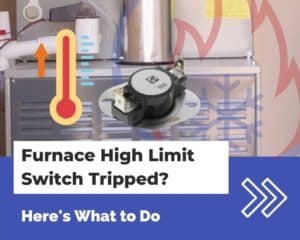Did your furnace completely lose power?
There’s a good chance that the circuit breaker tripped.
But why did the circuit breaker trip in the first place? Well, it could be due to a multitude of reasons.
In this article, I’ll go over the top 6 reasons why a furnace might trip its circuit breaker.
I’ll also discuss why it’s a bad idea to keep resetting a tripping circuit breaker, and what you should do instead.
Why your furnace is tripping its circuit breaker
Before I discuss why a furnace could trip a circuit breaker, I’ll tell you one thing.
If your furnace just tripped its circuit breaker, go ahead and reset the breaker and turn your furnace back on again.
There’s a chance that the circuit breaker tripped due to a temporary problem– such as a power surge or a problem from the electric company.
If your circuit breaker trips AGAIN, then you have an issue.
Here are the top 6 reasons why a furnace might trip its circuit breaker:
1. Airflow restriction
Having an airflow restriction in your furnace will cause it to trip its breaker.
What causes airflow restriction?
First, the most common thing: a dirty air filter.
Having a dirty air filter will restrict airflow going through your furnace and cause a circuit breaker to trip. Why does it do that?
When you have a dirty air filter, your furnace blower needs to work much harder to produce airflow.
Basically, it’s suffocating your furnace.
All of this strain on the motor will cause it to use more power than normal. Sort of like breathing heavily during a long run.
Another form of airflow restriction comes from closed air vents. A closed vent will restrict a furnace’s airflow discharge.
Another thing to check for is air blockage inside your ductwork.
One common thing I see is bent or a kinked flex duct. Having kinked ductwork is like having a kinked garden hose. It doesn’t allow for very much flow.
Sometimes ductwork can collapse, causing high pressures in your system and reduced airflow.
A good way to tell if you have airflow restriction is if your furnace runs for a bit, then trips its circuit breaker. This happens because the blower motor strains, causing it to heat up. The overheating motor pulls more power than normal, causing the circuit breaker to trip.
To fix airflow restriction issues the first thing you need to check is your air filter.
If your air filter is dirty, replace it.
You also should check your air ducts for any blockage or kinks, and make sure your air vents are open.
2. Blower motor capacitor
A bad blower motor capacitor is another super common reason why a circuit breaker might trip.
If you notice that your circuit breaker is tripping right when the blower motor tries to come on, then there’s a good chance that it’s the capacitor.
So why does a bad capacitor trip a circuit breaker?
The first thing that you need to understand is that an electric motor uses a lot of power when it starts up.
During the first second or two when a motor starts, it uses a huge spike of power to get it to start turning. This huge rush of power is enough to trip a circuit breaker under normal conditions.
This is where the capacitor comes in. A capacitor is like a battery. The main difference is that a capacitor is capable of releasing all of its energy in a very short amount of time.
Upon starting up, the blower motor uses the capacitor’s stored energy to get itself going.
If the capacitor is bad, then the blower motor tries to get all of its energy from your electrical circuit. Even though it just needs a few extra amps to get running, that can sometimes be enough to trip a circuit breaker.
Fortunately, capacitors are pretty cheap, and replacing them isn’t too hard.
This video from Repair Clinic shows what’s entailed in replacing a blower motor capacitor:
3. Blower motor is bad
A bad blower motor is another cause for a tripping circuit breaker.
One way that a blower motor can go bad is by seizing up. A seized motor will almost always trip a circuit breaker.
It’s easy to tell if a blower motor is seized– you just turn it with your hand.
If it’s difficult to turn or feels like it’s grinding then it’s time to get a new blower motor.
Sometimes it’s hard to tell if a blower motor is bad. It will spin just fine by hand, but still trips the breaker when you turn it on. In this case, the stator core or windings could be damaged.
Unfortunately, you’ll need to replace your blower motor if it has damage to the stator core or windings.
Keep in mind that the squirrel cage itself can cause a blower motor to trip. Sometimes, the squirrel cage will rub up against the side of the fan housing. When this happens, the blower motor can get stuck, causing the breaker to trip.
Fortunately, you can sometimes fix a squirrel cage by re-aligning it on the blower motor shaft.
If your squirrel cage is damaged but your motor is fine, then you only need to replace your squirrel cage.
4. Short circuit
A short circuit is another thing that will cause a furnace to trip its circuit breaker.
Short circuits are caused by the hot and neutral wires touching each other.
Ground faults happen when the hot wire touches a ground wire or grounded component– such as the metal housing of your furnace.
Short circuits and ground faults are similar to each other. They will both pull large amounts of current, tripping a circuit breaker.
Short circuits are caused by bad wiring or bad parts.
Wires that are touching are one of the most common causes of short circuits.
Malfunctioning furnace components are another cause of short circuits.
Finding a short circuit in your furnace can be incredibly difficult. It’s also dangerous since you’re dealing with line voltage wiring.
In fact, I recommend most people hire an HVAC professional if they think that they have a short in their furnace.
5. Loose wire
Believe it or not, loose wiring will trip a circuit breaker in no time at all.
Why does that happen?
Think of a loose wire like a weak connection. Weak connections have high resistance.
When there is high resistance in your circuit’s wiring, heat is produced. When your wires heat up, the circuit breaker trips.
Loose wires can also trip circuit breakers in other ways.
Most newer homes have Arc Fault Circuit Interrupters (AFCIs) installed in their breaker panel. AFCIs are more advanced than a standard circuit breaker because they protect against arcing faults.
An arc fault happens when electricity flows through an unintended path. In the case of a loose connection, electrical current flows through the air. The electrical arc produces extreme temperatures that are prone to starting fires.
AFCIs have circuitry that detects unintended arc faults. When one of these arc faults is detected, the circuit breaker trips to protect against high heat, temperatures, and fires.
If you suspect that your circuit breaker is tripping due to loose wiring, then the first thing you should do is turn off your circuit breaker.
Next, take a look at your wiring and make sure that it is all secure. It’s helpful to give all of your connections a slight tug to ensure that they are secure.
If you find a loose wire, tighten down the connection if it’s a screw terminal.
If it’s another kind of connection, such as a fork terminal, then you may need to replace the connector altogether.
6. Bad circuit breaker
If all else fails, your furnace’s circuit breaker itself could be bad.
However, the circuit breaker should be the last thing you check. In most cases, it’s not worth replacing the circuit breaker right off the bat, since it’s usually something else that’s at fault.
Only replace the circuit breaker after you’ve exhausted all other possibilities.
Replacing a circuit breaker is a fairly involved task. Rather than trying to explain it all here, I found this video from Silver Cymbal that shows the process from start to finish.
Why it’s a bad idea to keep resetting your circuit breaker
So, your furnace’s circuit breaker just tripped.
Just go reset it and keep on going, right?
Well, that’s probably not a good idea– especially if your circuit breaker trips again.
If your circuit breaker is tripping, then that’s a sign that something is wrong with your furnace.
Think of a tripped circuit breaker like a warning.
If the circuit breaker didn’t trip, then a lot more damage could happen.
Why is the circuit breaker important? It’s to protect your home’s wires.
If your furnace is drawing too many amps, then your wires will overheat. This could potentially start a fire. The circuit breaker trips before any fires can happen.
So what do you do if your circuit breaker keeps tripping? Check out our section on why your furnace is tripping its circuit breaker above.
How does a furnace breaker work?
Circuit breakers are overload protection devices. In layman’s terms, the circuit breaker protects against dangerous amounts of electricity from flowing within the wires in your home.
The circuit breaker also protects your furnace’s internal components from heating up and catching on fire if something goes bad.
Circuit breakers are rated for a certain amount of amps. For example, a circuit breaker could be rated for 15 amps. This means if your furnace consumes more than 15 amps at any given time, the circuit breaker will trip.
So how does a circuit breaker know that your furnace is consuming more than 15 amps?
Circuit breakers detect amps based on heat. The more amps that flow through a circuit, the more heat is generated.
When the circuit breaker heats up to a certain threshold, then it trips.
You’ll know that you have a tripped circuit breaker because the switch will be in the middle, rather than to the right or left. When you try to turn it back on, it will feel loose and won’t stay on.
To reset a circuit breaker, you need to turn it off, then turn it back on again.




So I have a Coleman electric furnace and the breaker keeps popping. Not the two in the heater but the 60 amp double pole in the panel. Had all components checked and supposed to be good. Replaced breaker, crossover tube is trashed have one coming, tomorrow. Some water may have dropped on top of unit due to old gas exhaust tube. Had it sealed but leaked in around one of the sleeves. Had fan running 36 hours to try and be sure it was dry. Anyway was hoping you may have some troubleshooting ideas.
Thanks
Hi Jayne,
Since you mentioned water on top of the unit, you should take a look and see if there is water damage to any of the components inside the furnace. Such as the blower, inducer, or transformer.
Hope this helps,
-Trey